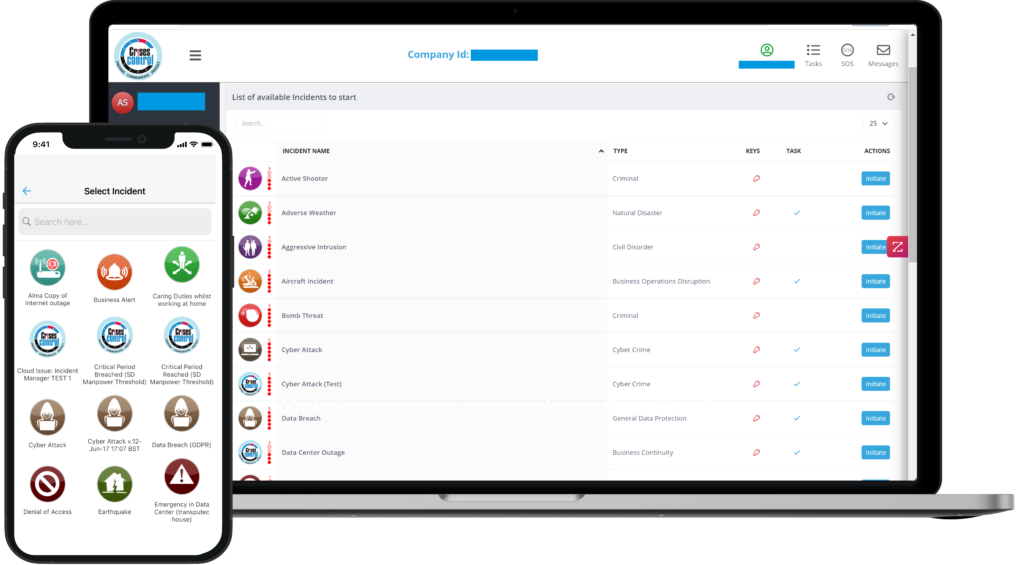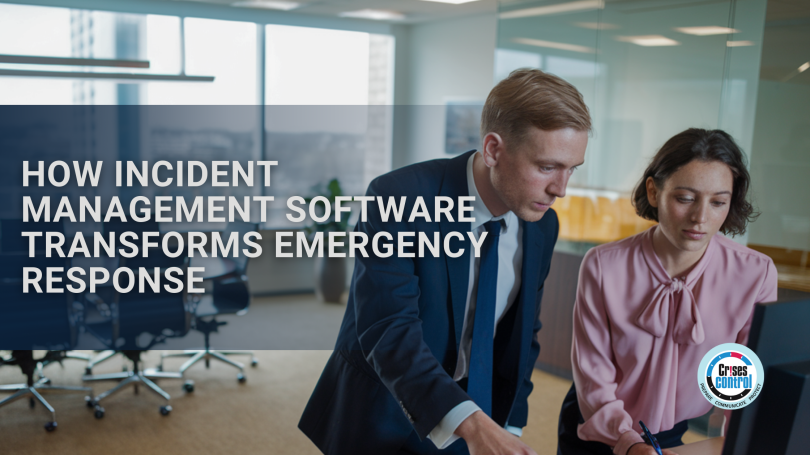Written by Anneri Fourie | Crises Control Executive
In a crisis, every second matters. Delayed communication, confusion over roles, and uncoordinated responses can turn a manageable incident into a full-blown disaster. Yet, many organisations still rely on slow, outdated methods like phone trees, scattered emails, and paper-based emergency plans. These methods not only waste valuable time, but also increase the risk of costly mistakes, putting people, operations, and reputations at stake.
Consider this: a major IT outage or a fire in your facility could disrupt operations within minutes. How quickly could your team respond? Would everyone know their roles? Would alerts reach the right people instantly? Would decision-makers have real-time updates to take control of the situation?
This is where Incident Management Software comes in. It automates emergency response, ensuring rapid communication, clear task assignments, and full coordination. In this blog, we’ll explore how this technology transforms crisis management and why businesses need a powerful, reliable solution like Crises Control.
The Challenges of Traditional Emergency Response
Many businesses still rely on manual, disconnected systems for handling emergencies. These outdated methods create five major challenges that slow down response times and increase risks:
1. Slow Notification Processes
Emergencies demand immediate action, but traditional methods rely on manual phone calls, emails, or text messages, which are slow and unreliable. Critical alerts may be missed, delayed, or sent to the wrong people, making it difficult to contain the situation quickly.
2. Confusion Over Roles and Responsibilities
In an emergency, every second of uncertainty matters. Who is responsible for what? Who needs to be contacted? Who has authority to make key decisions? Without a structured system in place, employees can become overwhelmed, leading to duplicate efforts or missed tasks.
3. No Real-Time Tracking of Incident Progress
Without a centralised incident dashboard, it’s nearly impossible to track progress. Are critical tasks being completed? Is the situation escalating? Are the right actions being taken? A lack of visibility can lead to poor decision-making and delays in containment.
4. Poor Communication Across Teams and Locations
Crises don’t happen in a bubble. Whether it’s a cyberattack, natural disaster, or operational failure, incidents often require coordination across multiple teams, departments, or even locations. Without a single, connected platform, communication breaks down, increasing confusion and risk.
5. Compliance and Post-Incident Reporting Challenges
After an incident, organisations must review what happened, ensure compliance with regulations, and identify areas for improvement. But if emergency data is spread across emails, handwritten notes, and verbal reports, gathering accurate insights becomes difficult, leaving businesses vulnerable to compliance failures.
How Incident Management Software Transforms Emergency Response
Incident Management Software eliminates these challenges by automating critical processes, enhancing coordination, and ensuring immediate action. Let’s explore how.
1. Instant, Multi-Channel Emergency Alerts
A slow response can turn a minor issue into a major crisis. Automated alerting ensures that the right people are notified immediately, without delays or manual errors.
Instead of relying on slow manual calls, Incident Management Software can instantly send:
- SMS, email, and voice alerts
- Push notifications to mobile devices
- Geo-targeted alerts for specific locations
How Crises Control Helps
- Ping Mass Notification delivers instant alerts across multiple channels to ensure immediate awareness and action.
- Users can predefine alert templates, reducing response times when seconds count.
- Real-time tracking shows who has received, read, and acknowledged alerts.
2. Automated Task Assignment and Real-Time Tracking
Emergencies require structured, coordinated responses. Incident Management Software ensures that every action is assigned, tracked, and completed, without confusion.
How Crises Control Helps
- Incident Plan Builder creates structured response plans that automatically assign tasks based on the nature of the crisis.
- The Task Manager tracks progress and escalates tasks if they are not completed within a set timeframe.
- The live dashboard gives managers a real-time overview of response efforts.
3. Seamless Communication and Collaboration
Emergency response depends on clear, reliable communication. A centralised platform ensures that all stakeholders stay informed and can collaborate in real time, no more scattered emails or missed calls.
How Crises Control Helps
- The Crises Control Dashboard provides a single source of truth, eliminating communication gaps.
- Two-way messaging allows employees to report real-time updates on the situation.
- Integration with security systems, alarms, and IoT sensors ensures a fully connected response.
4. Data-Driven Decision Making and Automated Workflows
Making the right decision in an emergency is critical, but without accurate data, businesses rely on guesswork. Incident Management Software provides real-time insights and automated workflows to improve response times and coordination.
How Crises Control Helps
- Real-time situational intelligence gives decision-makers up-to-date information to make informed choices.
- Automated incident escalation ensures that tasks are reassigned if personnel do not respond.
- Comprehensive reporting helps businesses analyse response effectiveness and refine future plans.
5. Compliance, Reporting, and Continuous Improvement
Regulatory compliance is a major concern for many industries. Incident Management Software ensures that every step of an emergency response is recorded, auditable, and compliant.
How Crises Control Helps
- Automated reports provide a clear, auditable record of all actions taken during an incident.
- Post-incident analysis helps businesses identify gaps and continuously refine their emergency response.
- Compliance tracking ensures that businesses meet industry regulations and legal requirements.

Interested in our Incident Management Software?
Customise your Crisis Incident Management Software to meet your specific needs with our flexible tools & stay connected and informed during the crisis and incident management process
The Business Benefits of Incident Management Software
Investing in a modern, automated emergency response system delivers real, measurable benefits:
- Faster Response Times: Immediate alerts and automated workflows prevent delays in crisis situations.
- Better Coordination: A centralised platform ensures that all teams are aligned.
- Fewer Human Errors: Automated processes reduce mistakes in high-pressure situations.
- Stronger Compliance: Businesses maintain audit-ready reports for regulators.
- Enhanced Business Continuity: Rapid response reduces downtime, minimising financial and operational impact.
Conclusion: Future-Proof Your Business with Crises Control
Emergencies can strike at any time. Whether it’s a cyberattack, natural disaster, or workplace incident, the ability to respond quickly and effectively can mean the difference between business continuity and catastrophe.
Crises Control provides powerful, easy-to-use Incident Management Software that transforms emergency response. With instant alerts, automated task management, real-time tracking, and compliance reporting, we ensure that businesses can act decisively when it matters most.
Don’t wait until an emergency exposes gaps in your response strategy. Contact us today for a free personalised demo and see how Crises Control can strengthen your incident management approach.
Request a FREE Demo








